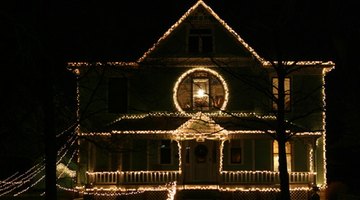In the whirlwind of holiday decorating, shopping and festivities you might find yourself opening a package of lights to hang on your porch only to discover that the box is marked "indoor." Indoor and outdoor lights are very similar in appearance and function, and you may be tempted to use them interchangeably. Don't make this mistake.
Misconceptions
Many people believe that it is safe to hang indoor Christmas lights outside and to put outdoor lights on the tree. This is a common misconception. Lights that are certified for outdoor use are specifically made to withstand cold and wet conditions, and lights that are certified for indoor use have been safety tested to make sure that they are not a fire hazard for trees.
Types
There are three types of Christmas lights; those marked for outdoor use only, those for indoor and those that are certified for both. The authorities recommend that consumers use only lights certified by an approved testing facility, so check the box before you buy. If you are decorating with last year's lights brought up from the basement, the tag near the plug should tell you if they are outdoor or indoor lights. If you are unable to verify what type of lights they are, don't use them.
- There are three types of Christmas lights; those marked for outdoor use only, those for indoor and those that are certified for both.
- If you are decorating with last year's lights brought up from the basement, the tag near the plug should tell you if they are outdoor or indoor lights.
Safety
The Consumer Products Safety Commission warns against using Christmas lights outside unless they are certified for outdoor use. If you decorate your porch with lights designed for indoor use only, they could break down in harsh weather conditions. Damaged lights pose a risk for fire or injury through electrical shock. Similarly, outdoor lights used indoors may become a fire hazard because they are often hotter than standard tree lights.
- The Consumer Products Safety Commission warns against using Christmas lights outside unless they are certified for outdoor use.
- Similarly, outdoor lights used indoors may become a fire hazard because they are often hotter than standard tree lights.
Benefits

If you choose the right types of lights when purchasing your Christmas decorations, you will do more than just help to ensure the safety of your family over the holidays. You will find that your outdoor lights are large and bright enough for passersby to see from the road, while the lights on your tree will be just the right size and cool enough to rest against thin needles and not start a fire.
Options
Another option for the safety-conscious consumer is LED Christmas lights, which come in both indoor and outdoor varieties. LED bulbs last longer and are much cooler than traditional incandescent Christmas bulbs. They also require significantly less electricity than standard lights. Running LED lights for 12 hours a day for forty days would cost under a dollar. In comparison, a Christmas tree with standard C-7 lights lit for the same amount of time would cost around £16, as of June 2012.
- Another option for the safety-conscious consumer is LED Christmas lights, which come in both indoor and outdoor varieties.
- In comparison, a Christmas tree with standard C-7 lights lit for the same amount of time would cost around £16, as of June 2012.
